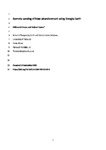Remote sensing of boat abandonment using Google Earth
| dc.contributor.author | Payne, MR | |
| dc.contributor.author | Turner, Andrew | |
| dc.date.accessioned | 2022-11-14T13:07:07Z | |
| dc.date.issued | 2022-09-28 | |
| dc.identifier.issn | 0944-1344 | |
| dc.identifier.issn | 1614-7499 | |
| dc.identifier.uri | http://hdl.handle.net/10026.1/19966 | |
| dc.description.abstract |
Abandoned boats represent a pervasive and growing problem in the coastal zone that has received little regulatory or scientific attention. In this study, we show how Google Earth can be employed to remotely identify abandoned boats and provide information on their size, age and condition. Based on specified criteria for abandonment, a survey of southern England (1700 km in length) revealed the presence of 266 boats that were mainly located in the intertidal zones of estuaries and inlets and that were often contained within clusters. Boat length ranged from 2.6 to 60 m (median = 10.5 m), and since 2004 abandonment has been increasing at a rate of about eight per year. The majority of boats appeared to be of timber construction and exhibited evidence of damage and water-sediment ingression. The environmental impacts are likely to be most significant where boats are clustered on protected mudflats. | |
| dc.format.extent | 15616-15622 | |
| dc.format.medium | Print-Electronic | |
| dc.language | en | |
| dc.language.iso | eng | |
| dc.publisher | Springer Science and Business Media LLC | |
| dc.subject | Abandoned boats | |
| dc.subject | Google Earth | |
| dc.subject | Remote sensing | |
| dc.subject | Intertidal zone | |
| dc.subject | Antifouling paint | |
| dc.subject | Regulations | |
| dc.title | Remote sensing of boat abandonment using Google Earth | |
| dc.type | journal-article | |
| dc.type | Journal Article | |
| plymouth.author-url | https://www.webofscience.com/api/gateway?GWVersion=2&SrcApp=PARTNER_APP&SrcAuth=LinksAMR&KeyUT=WOS:000861188200011&DestLinkType=FullRecord&DestApp=ALL_WOS&UsrCustomerID=11bb513d99f797142bcfeffcc58ea008 | |
| plymouth.issue | 6 | |
| plymouth.volume | 30 | |
| plymouth.publication-status | Published online | |
| plymouth.journal | Environmental Science and Pollution Research | |
| dc.identifier.doi | 10.1007/s11356-022-23102-9 | |
| plymouth.organisational-group | /Plymouth | |
| plymouth.organisational-group | /Plymouth/Faculty of Science and Engineering | |
| plymouth.organisational-group | /Plymouth/Faculty of Science and Engineering/School of Geography, Earth and Environmental Sciences | |
| plymouth.organisational-group | /Plymouth/REF 2021 Researchers by UoA | |
| plymouth.organisational-group | /Plymouth/REF 2021 Researchers by UoA/UoA07 Earth Systems and Environmental Sciences | |
| plymouth.organisational-group | /Plymouth/Research Groups | |
| plymouth.organisational-group | /Plymouth/Research Groups/BEACh | |
| plymouth.organisational-group | /Plymouth/Research Groups/Marine Institute | |
| plymouth.organisational-group | /Plymouth/Users by role | |
| plymouth.organisational-group | /Plymouth/Users by role/Academics | |
| dc.publisher.place | Germany | |
| dcterms.dateAccepted | 2022-09-14 | |
| dc.rights.embargodate | 2023-9-28 | |
| dc.identifier.eissn | 1614-7499 | |
| dc.rights.embargoperiod | Not known | |
| rioxxterms.versionofrecord | 10.1007/s11356-022-23102-9 | |
| rioxxterms.licenseref.uri | http://www.rioxx.net/licenses/all-rights-reserved | |
| rioxxterms.licenseref.startdate | 2022-09-28 | |
| rioxxterms.type | Journal Article/Review |


